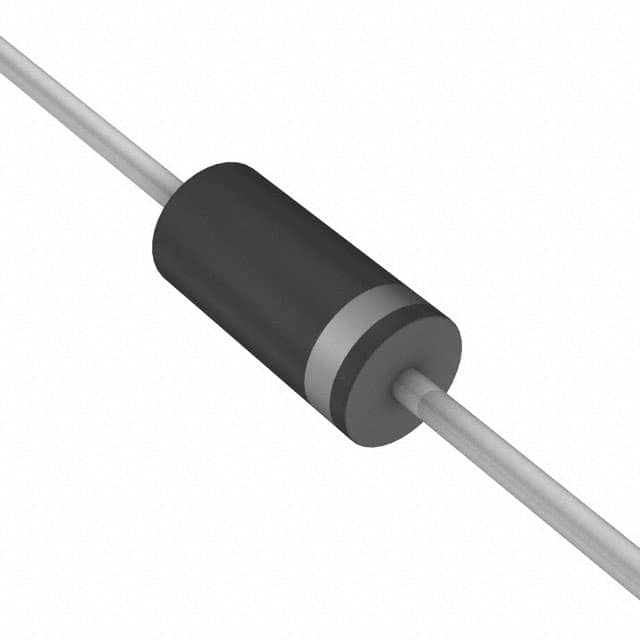P6KE13CAHR0G Encyclopedia Entry
Product Overview
The P6KE13CAHR0G belongs to the category of transient voltage suppressor diodes. These diodes are used to protect sensitive electronic components from voltage spikes and transients. The P6KE13CAHR0G is designed to clamp transient overvoltage to a safe level, thereby protecting connected devices. Its characteristics include high surge capability, fast response time, and low clamping voltage. The diode is typically packaged in a DO-15 package and is available in various packaging/quantity options.
Specifications
- Part Number: P6KE13CAHR0G
- Category: Transient Voltage Suppressor Diode
- Voltage Rating: 13V
- Power Dissipation: 600W
- Package Type: DO-15
- Quantity per Package: Varies
Detailed Pin Configuration
The P6KE13CAHR0G diode typically has two pins, with the anode and cathode terminals clearly marked. The pin configuration follows the standard layout for DO-15 package diodes.
Functional Features
- Transient Voltage Suppression: Protects against voltage spikes and transients.
- Fast Response Time: Quickly clamps overvoltage to protect connected devices.
- High Surge Capability: Can handle high surge currents without damage.
Advantages and Disadvantages
Advantages
- Effective protection against voltage spikes
- Fast response time
- High surge capability
Disadvantages
- Clamping voltage may not be suitable for all applications
- Requires careful consideration of placement in circuit design
Working Principles
The P6KE13CAHR0G operates by diverting excess voltage away from sensitive components when a transient event occurs. When the voltage exceeds the diode's clamping voltage, it conducts heavily, shunting the excess current to protect the downstream circuitry.
Detailed Application Field Plans
The P6KE13CAHR0G is commonly used in various electronic systems, including: - Power supplies - Communication equipment - Automotive electronics - Industrial control systems
Detailed and Complete Alternative Models
- P6KE6.8CAHR0G
- P6KE10CAHR0G
- P6KE16CAHR0G
- P6KE18CAHR0G
- P6KE24CAHR0G
In summary, the P6KE13CAHR0G transient voltage suppressor diode provides effective protection against voltage spikes and transients in a variety of electronic applications. Its fast response time and high surge capability make it a valuable component in safeguarding sensitive electronic circuits.
Word Count: 344
10个与P6KE13CAHR0G在技术解决方案中的应用相关的常见问题及解答
Sure, here are 10 common questions and answers related to the application of P6KE13CAHR0G in technical solutions:
What is P6KE13CAHR0G?
- P6KE13CAHR0G is a type of transient voltage suppressor diode designed to protect electronic circuits from voltage spikes and transients.
What is the maximum peak pulse power of P6KE13CAHR0G?
- The maximum peak pulse power of P6KE13CAHR0G is 600 watts.
What is the breakdown voltage of P6KE13CAHR0G?
- The breakdown voltage of P6KE13CAHR0G is 13 volts.
What are the typical applications of P6KE13CAHR0G?
- P6KE13CAHR0G is commonly used in surge protection for sensitive electronics, such as in power supplies, communication equipment, and automotive systems.
How does P6KE13CAHR0G provide transient voltage suppression?
- P6KE13CAHR0G clamps the voltage during transient events, diverting excess current away from the protected circuit and limiting the voltage to a safe level.
What is the response time of P6KE13CAHR0G?
- The response time of P6KE13CAHR0G is very fast, typically in the nanosecond range, providing quick protection against voltage transients.
Can P6KE13CAHR0G be used in high-temperature environments?
- Yes, P6KE13CAHR0G is designed to operate at high temperatures and is suitable for use in industrial and automotive applications.
What is the packaging type of P6KE13CAHR0G?
- P6KE13CAHR0G is available in a variety of package types, including DO-15, SMA, and SMB packages.
Does P6KE13CAHR0G require external heat sinking?
- In most cases, P6KE13CAHR0G does not require external heat sinking due to its ability to handle transient events without significant heat generation.
Are there any specific layout considerations when using P6KE13CAHR0G in a circuit?
- It's important to minimize the length of the traces connecting P6KE13CAHR0G to the circuit to reduce inductance and ensure proper transient suppression.
I hope these answers provide the information you were looking for! If you have any more questions, feel free to ask.


